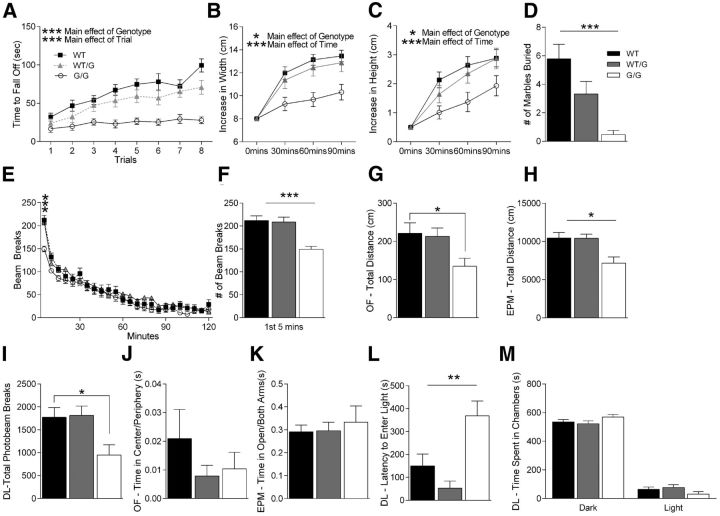Figure 3.
Shank3G/G mice exhibit impairments in behavioral tasks. A, Latency to fall from or to go one full revolution on the rotarod task. Shank3G/G mice exhibit motor coordination impairments in 8 trials of rotarod test conducted over 2 h. Legend in A applies to B, E. B, C, Width and height of nest built as a function of time in a nest-building task. Shank3G/G mice exhibit impairments in nest building behavior over a 90 min period. D, Number of marbles buried during a 30 min marble-burying task. Shank3G/G mice show impaired marble burying behavior. Legend in D applies to F–M. E, Locomotor activity as measured by number of photobeam breaks during successive 5 min intervals over a 2 h period. Shank3G/G mice exhibit normal locomotor habituation over the full 2 h period. F, Number of photobeam breaks during the initial 5 min of the locomotor task shown in E. Shank3G/G mice show decreased activity, initially suggesting abnormal locomotor response to novelty. G, Total distance traveled during the 5 min elevated plus maze task. Shank3G/G mice have decreased locomotor activity in the elevated plus maze task. H, Total distance traveled during the 10 min open field task. Shank3G/G mice have decreased locomotor activity in the open field. I, Number of photobeam breaks during the 10 min dark/light task. Shank3G/G mice have decreased locomotor activity in dark/light. J, Ratio of time spent in the center to time spent in the periphery in an open field task. No differences were observed among genotypes. K, Ratio of time in the open arms versus time in other arms in the elevated plus maze task. Shank3G/G mice spend the same time in open versus closed arms compared with littermate controls. L, Latency to enter the light side of the dark/light apparatus. Shank3G/G mice exhibit an increased latency to enter the light chamber. M, Time spent in dark and light sides of the dark/light apparatus. No difference was observed in the total time spent in the dark versus the light side of the chamber: WT, n = 23; Shank3WT/G, n = 19; Shank3G/G, n = 19 for all panels. *p < 0.05. **p < 0.01. ***p < 0.001.

